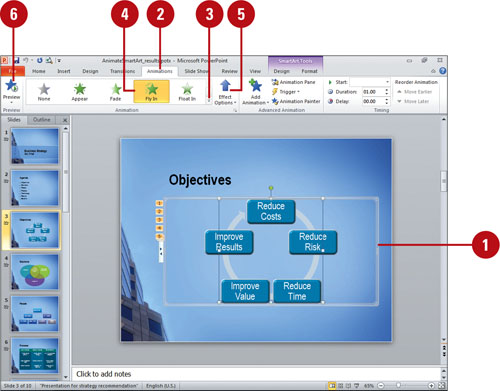SmartArt graphics allow you to create
diagrams that convey processes or relationships. You can add animation
to a SmartArt graphic to show information in phases on a slide one at a
time or with special animation effects. The easiest way to apply
animation effects to a slide show is to use animation commands on the
Animations tab. To quickly see if you like an animation, point to a
name in the Animation list to display a live preview of it. If you like
it, you can apply it. You can also design your own customized
animations, including those with your own special effects and sound
elements.
Animate a SmartArt Graphic
- 1. Select the SmartArt graphic you want to animate.
- 2. Click the Animations tab.
- 3. Click the Animation list arrow, and then point to an animation.
A live preview of the style appears in the current shape.
- 4. Click the animation you want.
- None. Removes the animation effect.
- 5. Click the Effect Options button, and then an option for the selected effect (options vary depending on the SmartArt graphic):
- As One Object. Animates the SmartArt object as a whole.
- All at Once. Animates all shapes at the same time.
- One by One. Animates each shape individually one at a time.
- 6. To see the animation effect, click the Preview button.

|
Animations you apply to a SmartArt graphic are
different from the ones you apply to text, shapes, or WordArt.
Connecting lines between shapes are associated with the second shape
and not animated individually. Shapes in a SmartArt graphic animate in
the order the shapes appear. When you convert a diagram created in an
earlier version of PowerPoint to a SmartArt graphic, you might loose
some animation settings.
|
|